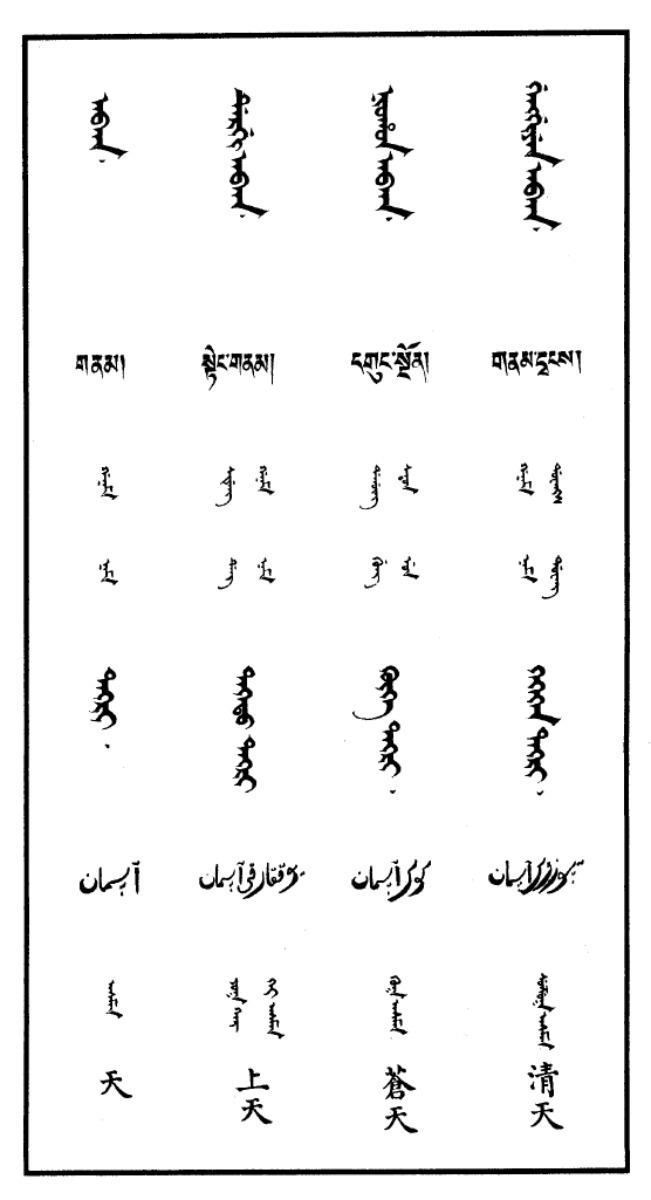Originally published 1 March 2014 | ||
 | ||
Similar Sacred Edict of the Kangxi E, Concise Dictionary of Spoke, The Five Thousand Dictionary, Mathews' Chinese‑English Dictionary | ||
The Pentaglot Dictionary (Chinese: 御製五體清文鑑, Yuzhi Wuti Qing Wenjian; the term 清文, Qingwen, "Qing language", was another name for the Manchu language in Chinese), also known as the Manchu Polyglot Dictionary, was a dictionary of major imperial languages compiled in the late Qianlong era of the Qing dynasty (also said to be compiled in 1794). The work contains Manchu lexemes and their translations into various administrative languages such as Tibetan, Mongolian, post-classical or vernacular Chagatai (Eastern Turki, now known as Modern Uyghur since 1921) and Chinese.
Contents
Title
The literal meaning of the Chinese title 《御製五體清文鑑》 Yù zhì wǔ tǐ Qīng wén jiàn is "Imperially-Published Five-Script Textual Mirror of Qing", which corresponds to Manchu ᡥᠠᠨ ᡳ ᠠᡵᠠᡥᠠ ᠰᡠᠨᠵᠠ ᡥᠠᠴᡳᠨ ᡳ ᡥᡝᡵᡤᡝᠨ ᡴᠠᠮᠴᡳᡥᠠ ᠮᠠᠨᠵᡠ ᡤᡳᠰᡠᠨ ᡳ ᠪᡠᠯᡝᡴᡠ ᠪᡳᡨ᠌ᡥᡝ᠈ han-i araha sunja hacin-i hergen kamciha manju gisun-i buleku bithe "dictionary of Manchu words written by the Emperor (i.e., by imperial order) containing five languages". The translations into the other languages are as follows:
Structure
The Yuzhi Wuti Qing Wenjian is organized into six boxes, containing 36 volumes on 2563 pages. The original work contained 32 volumes, with a four-volume supplement. It is divided into divisions (such as "Heaven Division"), category (such as "Astronomy"), with the categories further separated into types. There are 56 divisions, 318 categories, 616 types, with a total of 18671 terms. Each term has eight rows. From the top, the rows contain Manchu, Tibetan, a mechanical Tibetan transliteration into Manchu, a phonetic Tibetan transcription into Manchu, Mongolian, Chagatai, a transcription of Chagatai into Manchu, and Chinese.
For some terms, synonyms were included in the target languages (except Chinese). Thus, there are 19503 terms used in Mongolian corresponding to 18145 terms in Chinese (with 526 synonyms noted in Chinese). The Manchu text was largely based on the Beijing dialect of Manchu, using vertical regular script, with sentences terminated with punctuation (᠈ ), but no subsidiary pronunciation marks. Tibetan used the common written Tibetan usage at the time, in horizontal script in Uchen script (དབུ་མེད་), with terms that could not be written into a single line divided at syllabic boundaries, and terminating punctuation marks (།). Under the Tibetan was the Manchu transliteration, using Manchu phonemes to transliterate Tibetan letters to allow two-way transliteration and using distinctive characters for initial and medial phonemes; further, to transliterate some Tibetan letters, some new written forms for Manchu phonemes were invented (including initial "ng" and terminal vowels). Below the Manchu transliteration was the Manchu transcription to record the pronunciation in the Lhasa/Ü-Tsang dialect, due to the substantial difference between written Tibetan and spoken Tibetan. For Mongolian, the common written Mongolian of that time was used, in horizontal regular script, with punctuation marks at the end (᠈ ). Chagatai is written horizontally in Nastaʿlīq script, with terms that could not be written into a single line divided at syllabic boundaries and no terminal punctuations. Below Chagatai was Manchu transcription to record the eastern Xinjiang Turkic pronunciation, due to the substantial difference between Chagatai and the spoken language of Xingjiang at the time; the sounds showed characteristics of the pronunciations used in the Hami/Turpan regions; Chinese was spelled in traditional Chinese characters, also in vertical regular script, with the diction showing the influence of common usage in the Beijing Mandarin dialect. No punctuation or pronunciation marks were used.
Below were the renderings of the first term, "Heaven," on the first page of the first section, "Astronomy":
Manuscripts and editions
The Yu Zhi Wu Ti Qing Wen Jian has been transmitted in three known manuscripts, held by the Beijing Palace Museum, the Yonghe Temple, and the British Museum in London. A print edition doesn’t seem to exist. In 1957, the Ethnic Publishing House (Nationalities Publishing House, Minzu Chubanshe, 民族出版社) published a photo-mechanic reproduction of the dictionary, which was reprinted in 1998. In 1967, Japanese scholars recompiled the Yu Zhi Wu Ti Qing Wen Jian and added Latin transliteration into a work known as the Interpretation of the Wuti Qing Wenjian. In 1967, an edition was published in Japan that added transliterations of Manchu, the Manchu transcriptions of the other languages and a Japanese translation. In 2013, a critical edition with complete transliterations as well as indices for all five languages was published in Germany.
The Yu Zhi Wu Ti Qing Wen Jian is based on the Yu Zhi Si Ti Qing Wen Jian 御製四體清文鑑 ("Imperially-Published Four-Script Textual Mirror of Qing"), with Chagatai added as fifth language. The four-language version of the dictionary with Tibetan was in turn based on an earlier three-language version with Manchu, Mongolian, and Chinese called the Yu Zhi Manzhu Menggu Hanzi San He Jieyin Qingwen Jian 御製滿珠蒙古漢字三合切音清文鑑 ("Imperially-Published Manchu Mongol Chinese Three pronunciation explanation mirror of Qing"), which was in turn based on the Yu Zhi Zengding Qingwen Jian 御製增訂清文鑑 ("Imperially-Published Revised and Enlarged mirror of Qing") in Manchu and Chinese, which used both Manchu script to transcribe Chinese words and Chinese characters to transcribe Manchu words with fanqie. In Mongol the title of 御製滿珠蒙古漢字三合切音清文鑑 is "(Qaɣan-u bicigsen) Manzu Mongɣol Kitad üsüg ɣurban züil-ün ajalɣu nejilegsen toli bicig". In Manchu the title of 御製增訂清文鑑 is "Han-i araha nonggime toktobuha Manju gisun-i buleku bithe". It was used in banner schools as a textbook. A tetraglot dictionary (Yuzhi zengding Qingwen jian) in manuscript form exists in the Harvard-Yenching Library, where black ink is used for Chinese and Manchu and red ink for Tibetan and Mongolian. In 1708 the Yu Zhi Qingwen Jian 御制清文鉴 "han-i araha manju gisun buleku bithe" was published.
"gamma uc̆in nigen boti, orosil nigen boti".
